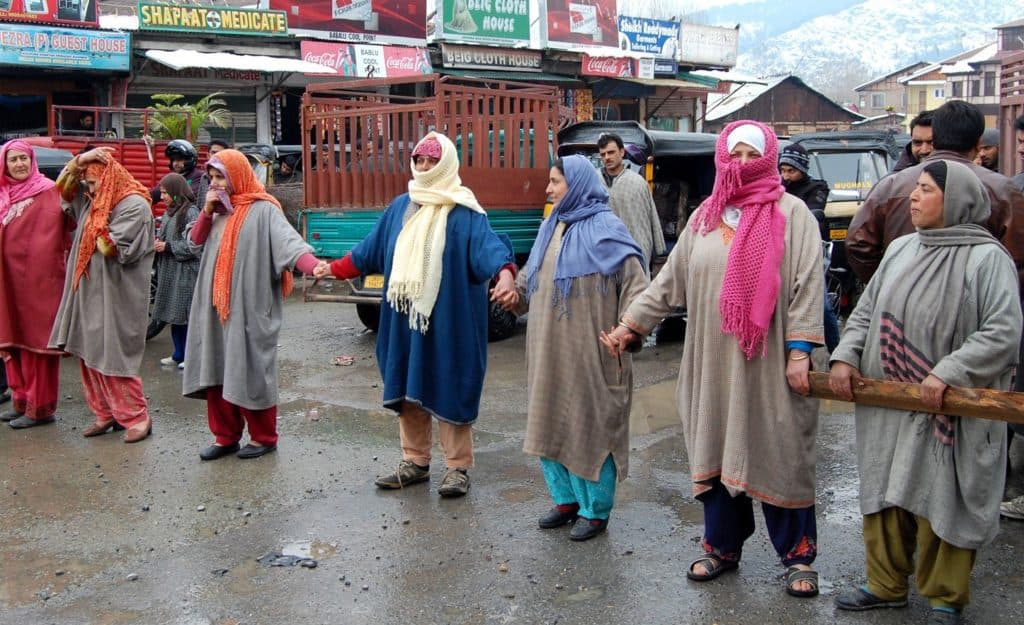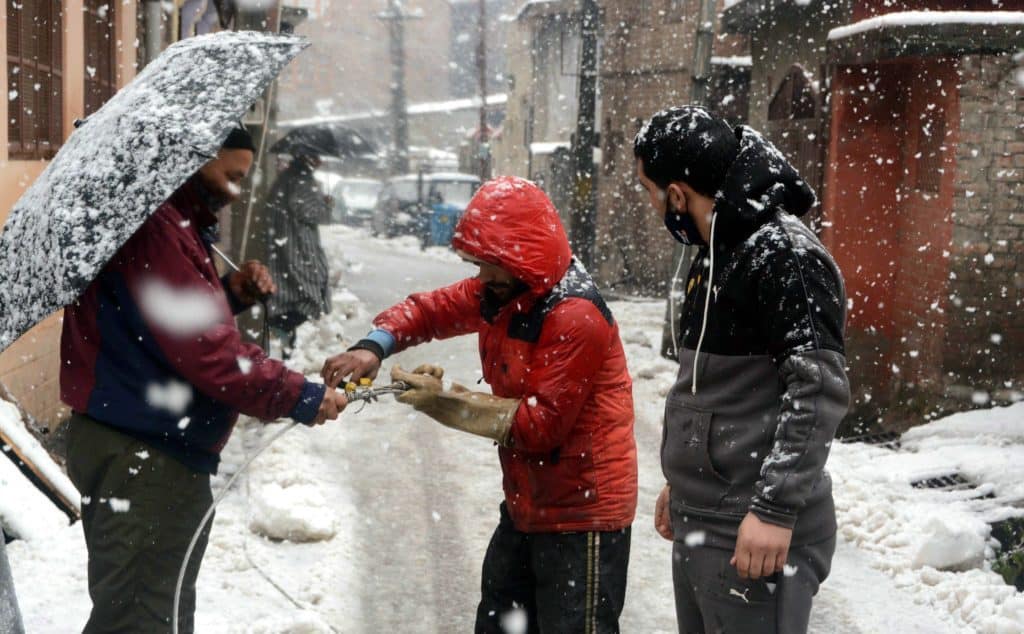Come the first signs of winter and 50-year-old Saleema, a resident of Panthachowk area of Srinagar, visits her 10-acre orchard for two hours daily to collect fallen leaves of the different variety of trees there. She also cuts small tree branches to keep with the leaves. Saleema along with her two daughters, Sab 15 and Iqra 13, then begin the process to turn the leaves and tree branches collected into a kind of coal to be used in fire-pots, popularly known as Kangris, a traditional heating pot which Kashmiris use to fight the bone chilling winter cold. Thanks to the acute power shortage in the region.
Scores of women in Srinagar do the same. Saleema has been doing this since she was married to Riyaz Ahmed, some 30 years ago. “This is our preparation for winters as Kangris are the only source that keep us warm,” says Saleema.
Apart from preparing the fuel for the kangris, Saleema and her daughters spend hours at home to ensure that the requisite stock of dried vegetables is preserved for the winter months. Also stored are varieties of dried fish, dried vegetables like brinjals, pumpkins, tomatoes and turnips. And pulses.
Despite all these preparations, what adds to the challenge of getting through winter is non-availability of electricity. Imagine a home without electricity when temperatures plummet to minus seven degrees during nights.
On January 19th, Srinagar recorded the coldest night of the season at minus seven degrees Celsius. Local residents have a name for the period from December 21st to January 31st — Chilla-e-Kalaan in Kashmiri parlance. This is a 40 day-long period of intense cold when the city also gets heavy snowfall spells that blocks road and air traffic for days together.
Read more: Closure of Srinagar’s precarious lifeline leaves citizens without essentials
Successive governments in Jammu and Kashmir have been making tall claims of providing uninterrupted power supply during winter, especially to Srinagar. But all, including the present dispensation, have failed to keep their promise. Lieutenant Governor Manoj Sinha in his Republic Day (January 26) speech claimed that his administration succeeded in providing 22% more power to J&K this winter. But it has also been an unusually cold winter season.
Since February 5th, day temperatures in Srinagar have been around nine degrees since February 5. The meteorologists are not forecasting any unusual cold wave, as yet. But the nights remain cold, the coldest night being minus 0.1 degrees on February 10th.

But power cuts continue to plague residents making coping with even these not so cold temperatures difficult to cope with.
Acute power shortage
“The power scenario has not improved, nor will improve in Kashmir,” says Ghulam Qadir Rather, a retired government employee and a Srinagar resident. “All governments and politicians have been making false claims about improving the power scenario. Even today, we face long power cuts in intense cold conditions.”
On December 7th, 2021, the Power Development Department (PDD) announced a six to eight hour power cut during the day in non-metered areas of Srinagar and four to six hours in metered areas, which cover just 30% of Srinagar according to the state power corporation. This will remain in force till March.
“In Srinagar, peak power demand during December-January is around 800 MW but availability is only 550 MW,” said Aijaz Ahmed Dar Chief Engineer Kashmir Power Development Corporation Ltd (KPDCL). “With a deficit of 200 to 250 MW, we have no option other than to go for power cuts.”
Dar however said that the onus lies on the people to use the available power judiciously. He accused people of resorting to illegal use of power. In Srinagar, it is common for people to steal power from HT lines by what the power department calls ‘hooking’, especially during morning and evening hours.
The Chief Engineer said that “J&K has been leading the country in power transmission and distribution losses for which people are largely responsible. We have been working to improve power infrastructure that includes setting up new grid stations, laying hi-tension wires etc and improving transformer network”.
Read more: Growing vegetables, storing rice: Lessons from Srinagar that has seen and survived many lockdowns
On January 5th and 6th, Kashmir witnessed the season’s first heavy snowfall. Srinagar, however, recorded less than five cm of snow, the lowest this season so far. Still, 49 feeders out of 266 were damaged due to snowfall. Officials in the power department said that some 20 transformers developed snags due to overloading while hi-tension (HT) lines fell at 15 locations in the city.

“All the feeders were restored within 24 hours,” said an official. “Faults developed in the transformers and HT lines were repaired and restored within just three days post snowfall. The damage was minimum.” Even as Srinagar received less snowfall this season, temperatures continue to remain below normal during nights.
Use of heating devices
In the absence of electricity, Kangris continue to the first choice of city residents as widespread use of heating gadgets often leads to load shedding and power breakdowns. Imtiyaz Ahmed, an executive engineer of PDD in Srinagar said that whenever power is available, people resort to hooking up room heaters and blowers and even use heaters for cooking, which puts extra burden on the transformers.
“People of Srinagar have now realized that using power heaters and room blowers will lead to extra power cuts, so majority of them are avoiding these gadgets now which is a good sign,” Ahmed said. Though illegal use power through hooking continues unabated across Srinagar, according to Ahmed.
Students and patients worst hit
As dark evenings haunt Srinagar residents, patients who are on oxygen support in homes and students are the worst affected. “Our local transformer developed a snag due to overloading on January 6th and power supply remained off for three days,´ said Moomin Aijaz, a class 12 student. “I missed my Zoom classes for two consecutive days”.
Umar Iqbal Dhar, president of Private Diagnostic Centers Association (PDCA) Kashmir said that winter brings a lot of misery for patients with chest complications, especially those who are on oxygen support.
“Since oxygen machines don’t work on invertor batteries, generators are the only source we rely on during long power cuts in the months of December, January and February,” said Umar Dhar. “Some NGOs are helping by providing generators, oxygen concentrators and cylinders to patients during winters”.
Exploring solutions
To try and improve the power situation, On January 31st, Divisional Commissioner Kashmir P K Pole chaired a meeting regarding installation of smart meters in Srinagar. An official statement said that Pole directed district administration and police to tackle amicably resistance by people over installation of smart meters.
“The Divisional Commissioner also directed concerned officers to create awareness among the people regarding utility and advantages of smart metering in ensuring constant supply of electricity.” The official statement added that Pole asked officials to involve opinion leaders, religious leaders and social activists to create awareness about installation of smart meters and their benefits.
Srinagar residents have been opposing installation of smart meters, raising questions over what the point of installing them could be when electricity itself was playing hide-and seek, and saying they would only cooperate when government can assure 24×7 electricity. Netizens also criticized government over the move. “This is another harassment,” posted a social media user Abrar.
The way forward
As per the Economic Survey Report of J&K government for the year 2017, the estimated hydro-power potential of Jammu and Kashmir is 20,000 MW, of which about 16,475 MW have been identified. “This comprises 11,283 MW in Chenab basin, 3,084 MW in Jhelum basin, 500 MW in Ravi Basin and 1608 MW in Indus basin,” says the report. “Only 3,263.46 MW, about 20% of the identified potential of 16,475 MW and only about 16% of the estimated potential of 20,000 MW has been exploited until now which comprises 1,211.96 MW in the state sector, 2,009 MW in central sector and 42.5 MW in private sector,” the report said.
Lieutenant Governor Manoj Sinha-led government and the Centre have signed several MoUs in the power sector, aimed at attracting investment of Rs 35,000 crore. Sinha unveiled this vision on power self-sufficiency at an official function at SKICC on the banks of the Dal Lake in June last year.
But the only thing that has happened so far is the signing of a host of MOUs between the state power development corporations and hydro power companies.